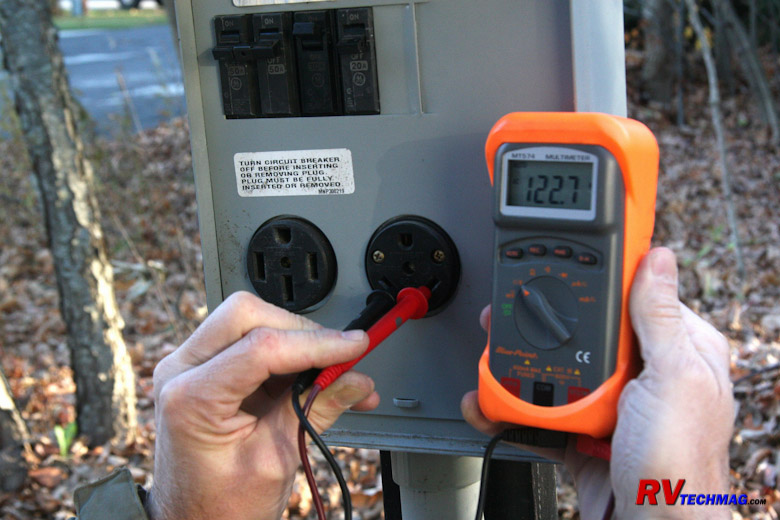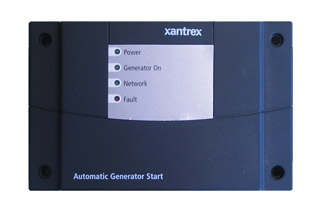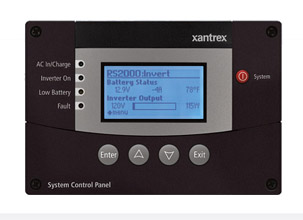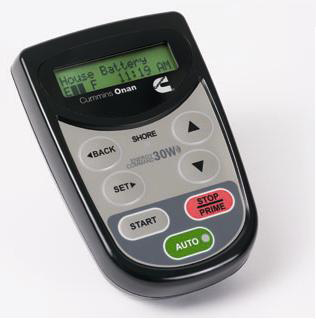|
RV Electrical Tutorial

Chapter 10 - Automatic Generator Starting
|

Xantrex AGS Module
|

System Control Panel
|
Automatic Generator Start (AGS) systems do just what you think they might do - they start your generator set
automatically, even if you are not near the coach. These systems vary in complexity and design. Some system are standalone systems
and are simply a module that connects to your generator set to start it if your batteries get low. Some systems, such as the
Onan EC-30, are an all-in-one system that builds the circuitry into its remote display and control panel. This system design
also includes a thermostat interface so that it can start your generator in response to a request for cooling from the air
conditioner's thermostat. Other systems, such as the Xantrex AGS module, are designed to network with an inverter and use
the same remote display panel as the inverter to control both the inverter and AGS module via menu driven software. So there
are a number of options and choices available when selecting an AGS module.

Onan EC-30 AGS Module
Selecting an AGS System:
The first thing to do is determine just why you want an AGS system in the first place. If you are only going to run
your generator to power air conditioning when driving you probably don't need one. If you will be dry camping quite often you will
need to run your generator every now and then to recharge your batteries. If your batteries drop below a given voltage your AGS can
start the generator set for you automatically while you are off sightseeing so that you don't return to a dead coach. This is the
basic feature of any AGS system. You can also recharge your batteries while you sleep if they drop down during the night without
having to worry about setting your alarm clock. Many campgrounds do have a quiet time posted where no generators may be run during
the evening. More advanced AGS models include a quiet time setting that can be set. In that case the AGS module will not start your
generator during those quiet time hours and will wait until morning to auto-start. Some models, like the Onan EC-30, include
predictive scheduling. The AGS will monitor your battery voltage level and if it determines that it will need to recharge them
during quiet time, it will start the generator earlier and then shut off so that they will be recharged when your quiet time begins.
The next level includes a thermostat interface. Your AGS system will be connected to your air conditioning system's
thermostat. If a request for cooling occurs, the AGS will start your generator and power the air conditioning system to prevent your
coach from overheating. Some systems also include a shore power connection so that the AGS will only start the generator if there is no
shore power present. This is a great feature for RVers who have pets and normally camp in full service campgrounds. The shore power
will power your coach's air conditioners to keep your pets from overheating. But, what happens if the shore power were to go out or
the pedestal breaker tripped while you were away from the coach? Your air conditioners would stop working and you might be returning
to a coach with pets that suffered heat stroke.
If you have an AGS that does not have a shore power sense, but does have a thermostat connection, you'll find that the
generator will start up every time the thermostat calls for cooling - even when the shore power is functioning. This is not desirable
so you will have to rig up a relay that is fired by the shore power side of the transfer switch and then intercept the low voltage
wires that connect the thermostat to the AGS module. This will break the circuit whenever shore power is present so that the AGS never
sees the input signal from the thermostat. When the shore power fails the relay will allow that connection to take place. With an AGS
that has shore power sense you won't have to worry about that. All of the logic is handled within the AGS electronics and it won't
start the generator if shore power is present. If shore power fails and cooling is desired it'll start the generator and your pets
will be safe.
Installing an AGS System:
The degree of difficulty in installing an AGS module varies as to how complex that particular system is. At the very
least, any AGS module needs to connect to the generator's start-stop switch, a chassis ground point, and a 12 volt hot feed. If the
AGS detects a drop in voltage below the programmed threshold it'll start the generator, and then stop it later on once the batteries
have been recharged. If you have a thermostat interface you'll have a pair, or two pair if it has dual inputs, of wires that need to
connect to the air conditioning system's thermostat. You may even have a shore power sense line that connects to a small transformer
mounted on the transfer switch and the next level is a number of safety inputs that can be connected to carbon monoxide detectors or
other safety inputs to shut down the generator if it feels there is unsafe operation. You'll also need to run a cat5 data cable to
a remote display. If your AGS module is designed to interface with an inverter you can probably just run the data cable to your
inverter and pick up the data buss there. In that case you'll be using the same remote display that the inverter uses. This simplifies
some of the installation process but you'll still need to make your basic generator set and thermostat connections. The module
itself can be mounted in the basement so it's not all that difficult to make the genset connections but you will have to fish wires up
to the thermostat, which will be more problematic.

Onan EC-30W Wireless AGS
The Onan EC-30 is probably the premier AGS system at this time. It offers the typical low voltage trigger as well as
two air conditioning thermostat interface channels, shore power sense connections, a ton of safety interlock connections, predictive
scheduling, and even flashes plain English descriptions of any trouble codes that may appear. Everything is contained in one compact
unit that also serves as the remote display and control panel. The only downside to this is that you need to run a ton of wires to the
EC-30, which is located in a wall mounted location inside the coach. That does add complexity to the installation process and it will
take some time to run all of those wires. Onan has released a new EC-30W wireless AGS system. The main unit attaches via a wye cable
to the generator set wiring harness. In addition to the basic wiring connections, it's a wireless receiver. The small remote keypad
is a transmitter that communicates with the main unit. It also serves as a temperature sensor for auto-start cooling so you do not have
to run any thermostat connection wires. You do have to be careful of where you place the remote though. If you set it in a hot spot it'll
be triggering the generator prematurely. You also run the risk of communications failure, which can happen with any wireless electronics
device, particularly when you consider that the signal needs to pass through the motorhome's steel firewall.
In the next chapter we'll move on to solar power as it applies to RVs.
Index
|



